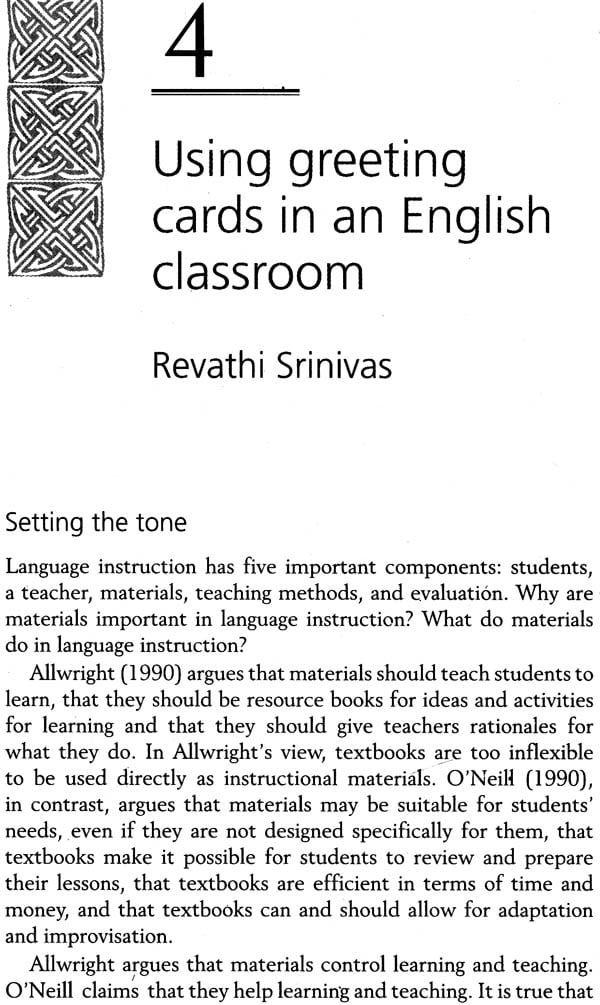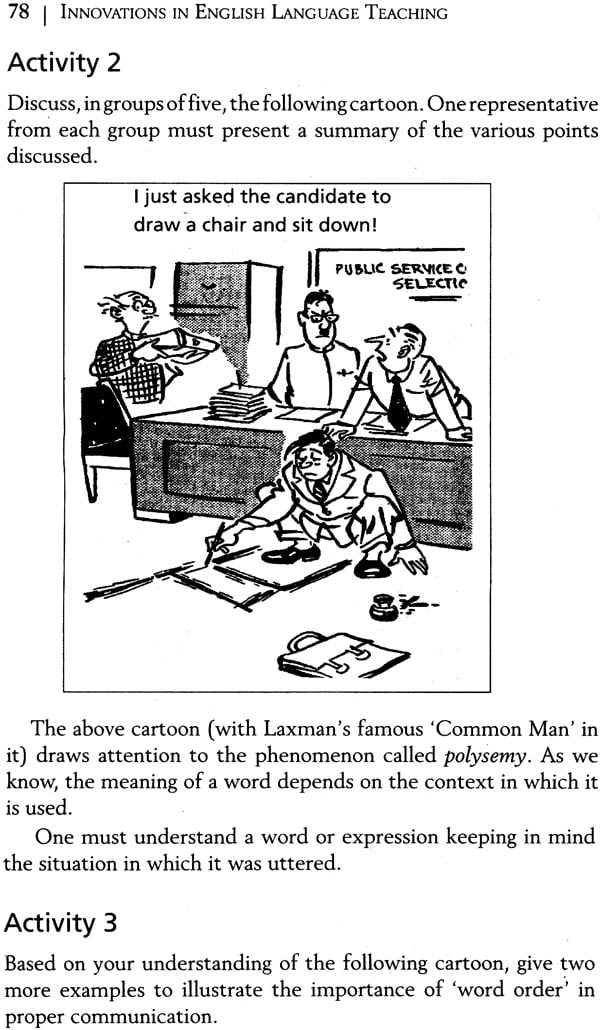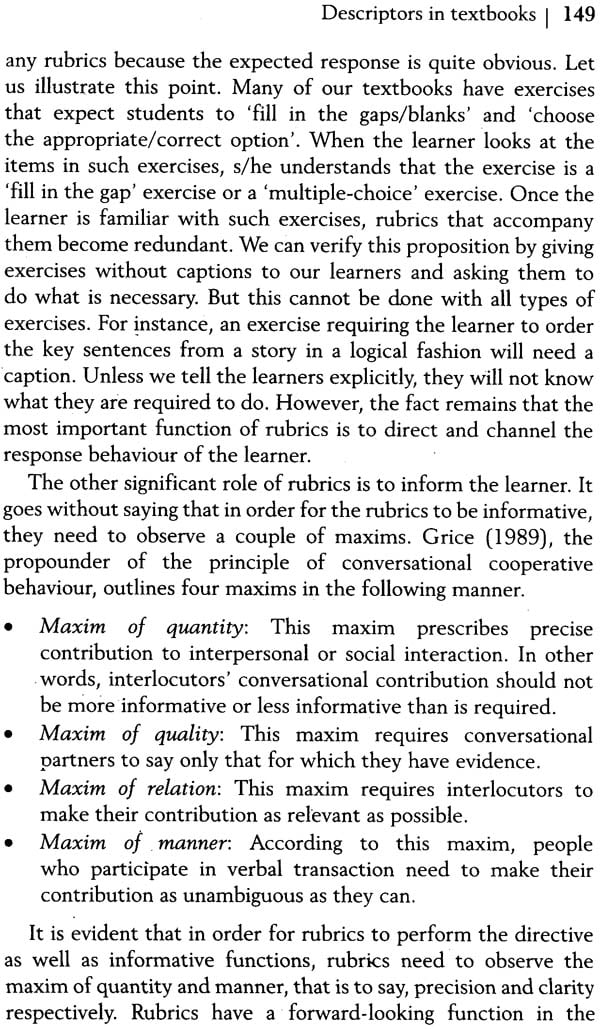
Innovations in English Language Teaching (Voices From the Indian Classroom)
Book Specification
| Item Code: | NAG077 |
| Author: | Z N Patil |
| Publisher: | Orient Blackswan Pvt. Ltd. |
| Language: | English |
| Edition: | 2012 |
| ISBN: | 9788125044772 |
| Pages: | 171 |
| Cover: | Paperback |
| Other Details | 8.5 inch X 5.5 inch |
| Weight | 170 gm |
Book Description
About the Book
Innovations in English Language Teaching: Voices from the Indian Classroom presents the views of a number of experienced classroom teachers of English in Indian who have realized the limitations of traditional pedagogical practices. The book embodies their desire and attempt to adopt a learner-centric approach and explore innovative materials and techniques of teaching English as a second/foreign language. Thus, the book is not based on the choices and decisions of theoreticians and syllabus designers, which are later imposed on teachers, but on the personal experience, the tested materials and strategies, and the distilled pedagogical wisdom of seasoned teachers of English.
The book is expected to be of immense value to all practicing teachers of English at the primary, secondary, higher-secondary and tertiary levels, and to teacher trainers and trainees. Students doing graduate and postgraduate courses in education will also find the book a reliable resource. The book will be equally useful to postgraduate students doing courses such as English Language and Literature Teaching (ELLT), offered by many universities in India.
Foreword
For about four decades after Independence, the population explosion in India did not affect the tone and tenor of higher education. We were, by and large, satisfied with the few schools and colleges we had and imparted to our students some regurgitated ideas contained in the rehashed books on sciences, social sciences and humanities. As for the teaching of English, we proudly confined ourselves to the teaching of Chaucer, Langland, Shakespeare and the like. The teaching of English as a language, that is, as a means of efficient expression and communication, was generally considered infra-dig in higher education. As a result of or in spite of this, English by and by acquired the hallmark of elitism even as, ironically, its users and learners continued to lose their command over the language.
Now, when as a result of explosion in higher education, particularly technical education, the use of English as a means of communication has become a vital requirement, most of our teachers do not know how to teach it. The teachers above forty-five years of age are still afflicted with the Chaucer-Langland-Shakespeare syndrome, and most of those below the age of forty-five who have been fed on some experimental methods of teaching cannot execute them or do not find them usable in their teaching situations.
But, thankfully, there are some enterprising teachers in the country, who have risen above the desire for a diploma or a degree and who have dared to use out-of-the box methods and materials of language teaching, in their classrooms. Innovations in English Language Teaching: Voices from the Indian Classroom is a judicious collection of such strategies and teaching materials. It is a very valuable addition to what has been said and done in the area of English pedagogy in the last few years. Some of the articles in this collection propose highly stimulating ideas and eminently practicable solutions to the problems of teaching and learning English. An imaginative exploitation of unconventional teaching materials (such as old newspapers, greeting cards, wrappers, labels, etc.), the teaching of macro and micro skills in an integrated way, and a whole lot of innovative strategies in the classroom are some of the more important examples of the rich material the book is made up of. I, therefore, believe that most teachers who teach English as a general means of expression and communication will find this book a very useful resource.
Introduction
In the recent pasty-many books have been written on English language teaching in India. Hence, one may wonder: why another book on the same subject? This book views the subject differently. It presents a plethora of voices trying to free themselves from the fetters of traditional practices in teaching the English language in the Indian context. The book begins with two thought-provoking articles, the first by N. Krishnaswamy and the second by Skand Shukla, on the need for innovations in ELT. These are followed by an article by Z. N. Patil and Yeasmin Sultana which attempts to dispel a popular misconception that the language skills can be segregated. Their article brings out the distinction between the popular perception of language as used in everyday situations on the one hand and the scholarly perception of language as treated in research and .pedagogy on the other. They advance their argument highlighting the properties which testify to the inherent inseparability of the four language skills.
The innovations that the contributors talk of in the book pertain both to methodology and materials in language teaching. The articles by Revathi Srinivas, Veena Ahire, Shivaji Kushwaha, Z. N. Patil and Anindya Syam Choudhury, and B. S. Jadhav focus on how various kinds of authentic materials like cartoons, newspaper middles, greeting cards, songs, anecdotes, malapropisms, wrappers, advertisements, etc., can be used as effective resources for developing the receptive skills of listening and reading and the productive skills of speaking and writing. Moreover, these articles demonstrate how readily available materials can be tapped to motivate language learners, sustain their interest, increase their involvement and develop their creativity. They also discuss ways to teach grammar and vocabulary in a resourceful manner. These articles mainly focus. on the practical aspects of the use of authentic materials in the language classroom.
There is no gainsaying that the growth and spread of English and information technology in India and the corresponding economic prosperity of the country are related. This relationship is highlighted in her article by Sulabha Natraj using trend analysis, an innovative research technique. The implication of her article is that the already advantageous position of India in terms of English language proficiency can be further consolidated through the use of information technology as an innovative method of teaching English. Along with the growth of English, the goals and objectives .of teaching English have also altered. Consequent upon these changes, there has been a paradigm shift in the roles of English language teachers and learners. Anindya Syam Choudhury focusses on the innovative classroom roles of English language teachers in the context of the current paradigm of task-based language teaching, contrasting them with the traditional ones.
Two articles in the book, one by Paritosh Chandra Dugar and the other by G. Suvarna Lakshmi, deal with the role of critical thinking skills in the ELT context and the techniques to develop them. Dugar's article substantiates his claims with actual experiments in Indian classrooms. The techniques discussed by G. Suvarna Lakshmi are given in the form of tasks to help the teachers understand their application in the classroom. Prashant Mishra, in his article, discusses some of the innovative strategies of teaching grammar in a communicative way such as prompting the learner to internalise grammar through meaningful situations. The last article in the book, written by Z. N. Patil and Gitashree Deori, examines descriptors and rubrics closely and elaborates on how teachers and students can benefit in several ways from the inclusion of descriptors in textbooks.
The aim of this book is not only to theoretically justify the need for innovations in English language teaching practice in the present context, but also to bring together the different voices of classroom practitioners from across India, who believe that in spite of inadequate resources, pedagogical innovations are viable and feasible in the Indian context.
Contents
| Notes of Contributors | vii | |
| Acknowledgements | ix | |
| Foreword | xi | |
| Introduction | xiii | |
| 1 | Innovations in the teaching of English a background study | 1 |
| 2 | Need for innovations in English language teaching | 4 |
| 3 | Reintegrating the integrated: Reflections on the teaching of language skills | 8 |
| 4 | Greeting cards: Authentic materials par excellence! | 19 |
| 5 | English songs for productive language learning activities | 33 |
| 6 | Best out of waste: Using low-cost and no cost authentic materials | 43 |
| 7 | Anecdotes and malapropisms for English language teaching | 58 |
| 8 | Using newspapers in the English classroom | 67 |
| 9 | English language, information technology and economy (ELITE): A novel perspective through trend analysis | 84 |
| 10 | The classroom roles of English language teachers: The traditional and the innovative | 92 |
| 11 | The role of critical and creative thinking in the TESL context | 101 |
| 12 | Techniques of teaching critical thinking skills | 113 |
| 13 | Teaching grammar the communicative way: Some strategies | 134 |
| 14 | Descriptions in textbooks: A case for their inclusion with special reference to writing skills | 145 |













